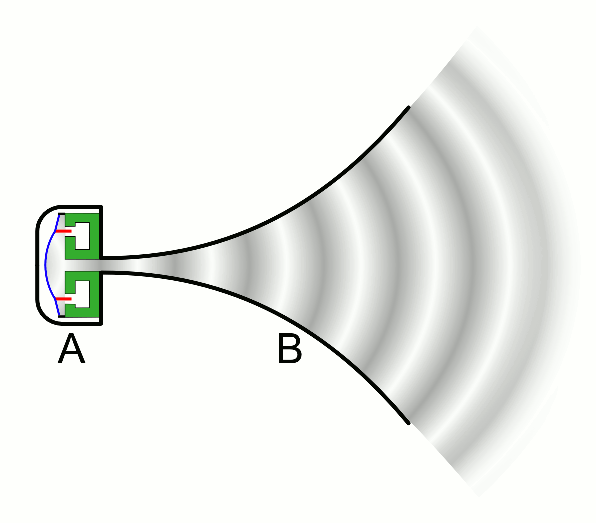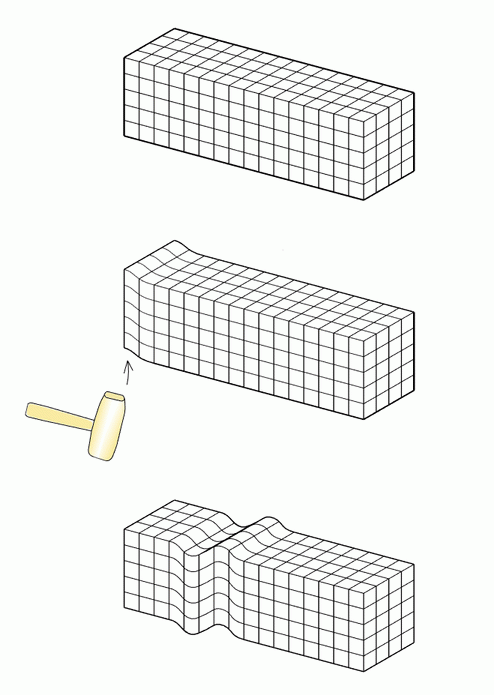| Vocademy |
Sound
Waves consist of energy that moves through a medium. A good example is surface waves on the ocean. As the waves move across the ocean surface, the water itself only moves up and down; the water does not move forward, but the wave does. Sound waves move through the air or solid material. With sound waves through the air, the air is alternately compressed and rarified. However, the air itself does not move along with the waves. Sound waves can propagate through fluid mediums (air and water) or solid mediums (an earthquake consists of powerful sound waves moving through the earth).
 |
| Sinusoidal waves of various frequencies; the bottom waves have higher frequencies than those above. The horizontal axis represents time. |
Perception of sound
The perception of sound in any organism is limited to a certain range of frequencies. For humans, hearing is normally limited to frequencies between about 20 Hz and 20,000 Hz (20 kHz), although these limits are not definite. The upper limit generally decreases with age. Other species have a different range of hearing. For example, dogs can perceive vibrations higher than 20 kHz but are deaf to anything below 40 Hz. Humans have developed culture and technology (such as music, telephone and radio) that allows us to generate, record, transmit, and broadcast sound. The scientific study of human sound perception is known as psychoacoustics.
Physics of sound
The mechanical vibrations that can be interpreted as sound are able to travel through all forms of matter: gases, liquids, solids, and plasmas. The matter that supports the sound is called the medium. Sound cannot travel through a vacuum (a vacuum is an absence of matter).
Compression waves and transverse waves
Sound propagates through gases, plasma, and liquid as compression waves (also called longitudinal waves). Through solids, however, it can be transmitted as both compression waves and transverse waves. Compression sound waves are waves of alternating pressure deviations from the equilibrium pressure, causing local regions of compression and rarefaction.
 |
| A horn-type loudspeaker producing compression waves. |
Transverse waves (in solids) are waves of alternating shear stress at right angle to the direction of propagation.
 |
| Transverse Waves |
Sound wave properties and characteristics
Sound waves are often characterized by these generic properties:
- Frequency (or its inverse, the period)
- Wavelength
- Amplitude
- Sound pressure
- Sound intensity
- Speed of sound
- Direction
Speed of sound
The speed of sound depends on the medium the waves pass through, and is a fundamental property of the material. The physical properties of the medium and the speed of sound change with ambient conditions. For example, the speed of sound in gases depends on temperature. In 20 ºC (68 ºF) air at the sea level, the speed of sound is approximately 767 mph. In fresh water, also at 20 ºC, the speed of sound is approximately 3,315 mph. In steel, the speed of sound is about 13,330 mph. The speed of sound is also slightly sensitive to the sound amplitude.
Acoustics
Acoustics is the interdisciplinary science that deals with the study of all mechanical waves in gases, liquids, and solids including vibration, sound, ultrasound and infrasound. A scientist who works in the field of acoustics is an acoustician while someone working in the field of acoustics technology may be called an acoustical or audio engineer. The application of acoustics can be seen in almost all aspects of modern society with the most obvious being the audio and noise control industries.
Noise
Noise is a term often used to refer to an unwanted sound. In science and engineering, noise is any unwanted component of a signal. Noise may be unwanted voltages introduced into cables by magnetic induction, tiny random currents caused by quantum effects in semiconductor devices or background sounds picked up by microphones.
Sound pressure level
Sound pressure is the
difference, in a given medium, between average local pressure and the pressure
in the sound wave.
As the human ear can
detect sounds with a wide range of amplitudes, sound pressure is often measured
as a level on a logarithmic decibel scale. The sound pressure level (SPL) or
Lp
is defined as...
|
|
where p is the RMS sound pressure and pref is a reference sound pressure. Commonly used reference sound pressures, defined in the standard ANSI S1.1-1994, are 20 μPa in air and 1 μPa in water. Without a specified reference, sound pressure, a value expressed in decibels cannot represent a sound pressure level.
Since the human ear does not have a flat spectral response (it does not respond to all frequencies equally), for measurement purposes, sound pressures are often frequency-weighted so that the measured level matches perceived levels more closely. The International Electrotechnical Commission (IEC) has defined several weighting schemes. A-weighting attempts to match the response of the human ear to noise and A-weighted sound pressure levels are labeled dBA. C-weighting is used to measure peak levels.
Sound
| Vocademy |